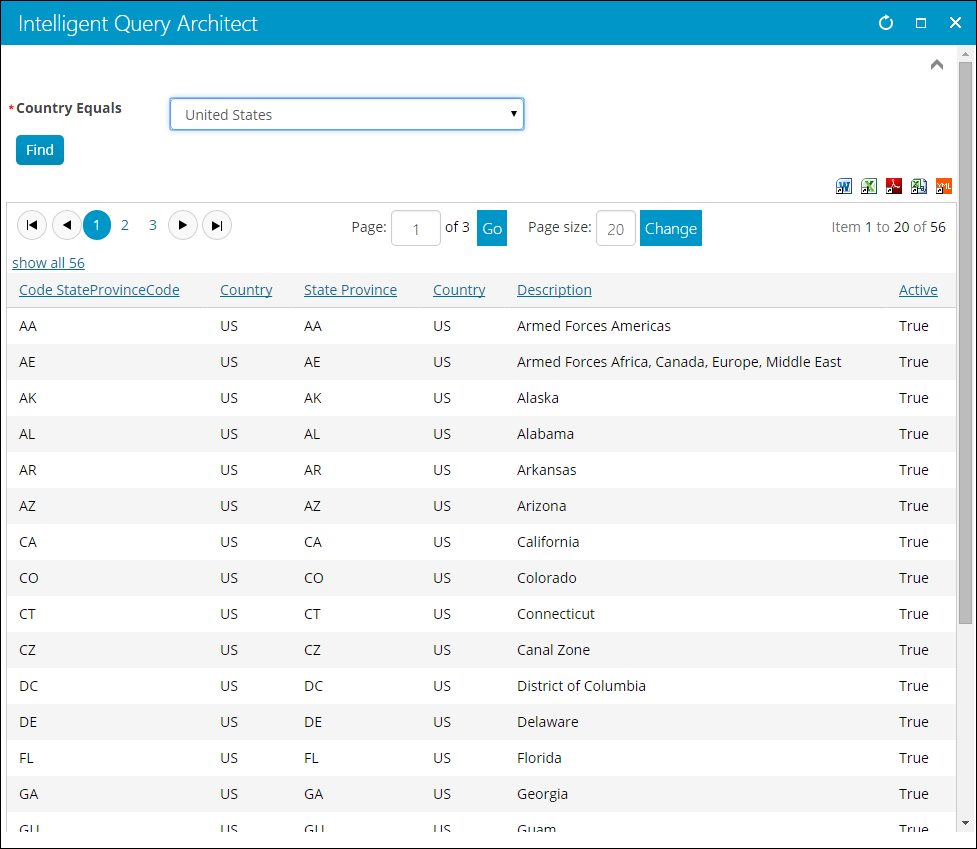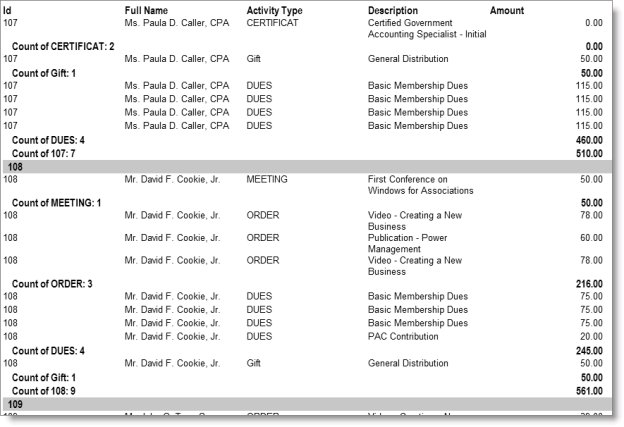Reporting in IQA
This Report view is a fast and easy way to create and print new iMIS reports and to generate starter reports for later development.
IQA reporting lets you:
- Export rendered reports to .PDF format, for archiving, sharing, and printing, and to .XLS format, for spreadsheet usage
- Customize the generated reports: totals, subtotals, summaries (Total Only), parameters (associated in the query)
- Save the reports into the Document System, which automatically adds the new template (.RDL) and its matching output process (binding query, template, and security to a report name you choose)
- Save the generated template file (.RDL) locally, to customize later in SQL Server Business Intelligence Development Studio
- iMIS integrates with the Microsoft SQL Server Reporting Service (SSRS)
- iMIS also harnesses it to bring dynamic reporting capability to iMIS queries.
- IQA reporting makes it possible to turn any query into an SSRS report:
- Filtered and auto-formatted
- Customized with sub-totals and layout settings
- Easily saved back into the Document System
- Easily saved to your workstation as an .RDL
- Free report customization in Business Intelligence Studio
- Every working query in iMIS can render a report in one click, without any modification
- Create reports on the fly without having to learn a report designer
- Reports inherit whatever filters the query contains
- Changes to the query show up in IQA reports immediately
- Built-in report navigation: start, end, next/previous page, jump to page
- Query result columns become report columns
- Formatting adjusts to fit the number of columns
- Change column order just by reordering them in the query
- No garbage: if you just create, view, and close a report, no files save or accumulate
- You save your query changes separately from the report
- Save to iMIS creates the report and template pair wherever you choose in the Document System
- Saved reports can be exposed and shared throughout iMIS as any other report
- Save to Workstation creates the report template (.RDL) on your file system, for offline editing
- Exports report data to Excel (XLS) format
- Exports formatted report to Adobe PDF
- On the Display tab of queries, columns can be subtotaled and totaled
- Sort order controls order of subtotaling
- Use Totals Only to create a summary view, of subtotals without data lines
- SystemConfig table holds SSRS parameters that set layout and formatting of all IQA reports
- Control page size (such as A4 versus Letter) and lay out headers and footers
- Control fonts, background and foreground colors, shading and separator lines
- Set report language and unit of measure
You can apply one or more subtotals in your query definition. In Reporting Services terms, subtotals are “groups”. When you enable Subtotal for a Display enabled field, a group is added. The groups nest in the Order you specify after Subtotal.

Using subtotals in the definition of a simple Activity List query
Note: If you see ReportViewer errors, you might have an older control. To get the newer version, search the web for Microsoft Report Viewer Redistributable 2005 SP1 (Full Installation), which is available for free download from several sites.
In the output, group headers appear for the first group only; group footers, with a count and the value being grouped, print for all groups.
Below is the third page of the generated report. The Report Viewer provides navigation controls on its toolbar to let you jump to the first page, last page, next page, previous page, and specific page number:

In this example, ID 108 has 9 activities (separate Activity Types): 1 meeting, 3 orders, 4 dues, and 1 gift.
In the example above, each Count row includes a sum of the Amount for that line. This happens automatically if your subtotaled query has a Display Property that includes the words Amount or Amt (the property name is not case-sensitive). You can sum other numerical display properties by giving it an Alias on the Display tab that contains Amount or Amt.
For example, if your subtotaled query includes the CsOrders.Balance property, you can sum the balance for any Count rows by changing the Alias to Balance Amt or simply Amount – both variations work.
IQA reporting layout is driven by global parameters that you control.
The Report view uses layout parameters stored in the iMIS SystemConfig table, so you can change parameters once (such as to assign corporate colors or A4 paper size) and have all IQA reports conform to your standards across the organization.
This IQA-based reporting works with all of your queries, old and new. Everything you need for IQA reporting is distributed with iMIS. No additional licensing is needed for the ReportViewer control, which is a Microsoft redistributable component. Nor do you need to install Reporting Services on SQL Server, since the Report Viewer does all the needed processing.
Note: If you see ReportViewer errors, you might have an old ReportViewer control. To get the newer version, search the web for Microsoft Report Viewer Redistributable 2005 SP1 (Full Installation), which is available for free download from several sites.
The optional applications are also free:
- Adobe Acrobat Reader, for opening and printing PDFs (install on workstations)
- SQL Server Business Intelligence Studio, for customizing RDL files externally, if needed

